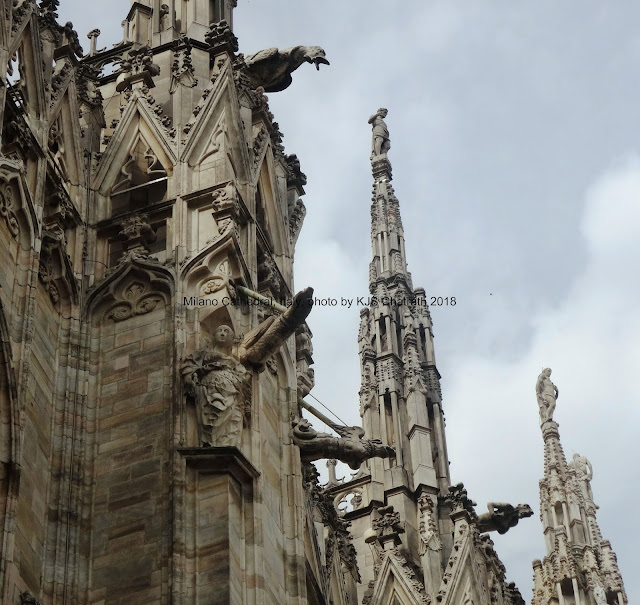'Gargoyles of the Milano Cathedral, Italy' - by K.J.S.Chatrath
I have been fascinated by gargoyles for quite a while now. A gargoyle is a carved or formed grotesque with a spout
designed to send water from a roof and away from the side of a building,
thereby preventing rainwater from running down masonry walls and eroding the
mortar between. I have been taking photos of gargoyles
during my trips to various countries and also to Hindu temples in India.
I would be putting up these photos separately. However when I
recently visited the Milano Cathedral in Italy I saw the structure
really studded with gargoyles. The Duomo has 3400 statues, 700 figures
and 135 gargoyles, including 96 large ones.
The word gargoyle derives from the French gargouille, meaning "throat." gargoyle, quite likely, comes from the French legend of "La Gargouille," a fearsome dragon that terrorized the inhabitants of the town of Rouen.As the legend has it, around 600 AD, there lived a dragon called Gargouille in a cave on the banks of the River Seine near Rouen. It had wings, a reptile's body with a long tail, clawed feet, and fiery eyes and breath. It spread terror amongst the inhabitants of the area causing devastation and death, and its fury was placated only by human sacrifices. It was St. Romanus who, according to legend, arrived in the city and succeeded in capturing the monster. The dragon's head and neck were placed on the walls of Rouen, the ramparts defending a city. By the way, I am planning to visit Rouen in November this year to take some photographs and learn more about this legend.
While the gargoyles prevent damage to the Cathedral and can therefore be called as the protectors, it is difficult to link the grotesqueness of their shapes to any technical reasons.These gargoyles were inserted into the masonry and therefore, depending upon their position with respect to the phases of construction of the Cathedral, it is possible to determine the date when they were carved: from the end of the 14th century, to the 18th century, when the walls of the last bays to be built were completed with decorative and symbolic elements.
In an attempt to raise money for necessary repairs to the Duomo, authorities have decided to create an 'adopt a gargoyle' scheme. Floaters of the scheme are hoping to raise €25million, which will be enough to cover all the repair costs. Any benefactor who contributes over €100,000 (Indian Rupees 82,00,000 aprox.) to the cathedral will have their name inscribed underneath a gargoyle. Reportedly so far, the cathedral have received eight donations of €100,000 as well as several smaller donations.
The gargoyles on show in the museum are the works of anonymous masons. These were
removed to preserve them during the restoration work on the external walls of
the Duomo from the 1960s onwards.
(Text based on information sourced from the internet)

















Comments
Post a Comment